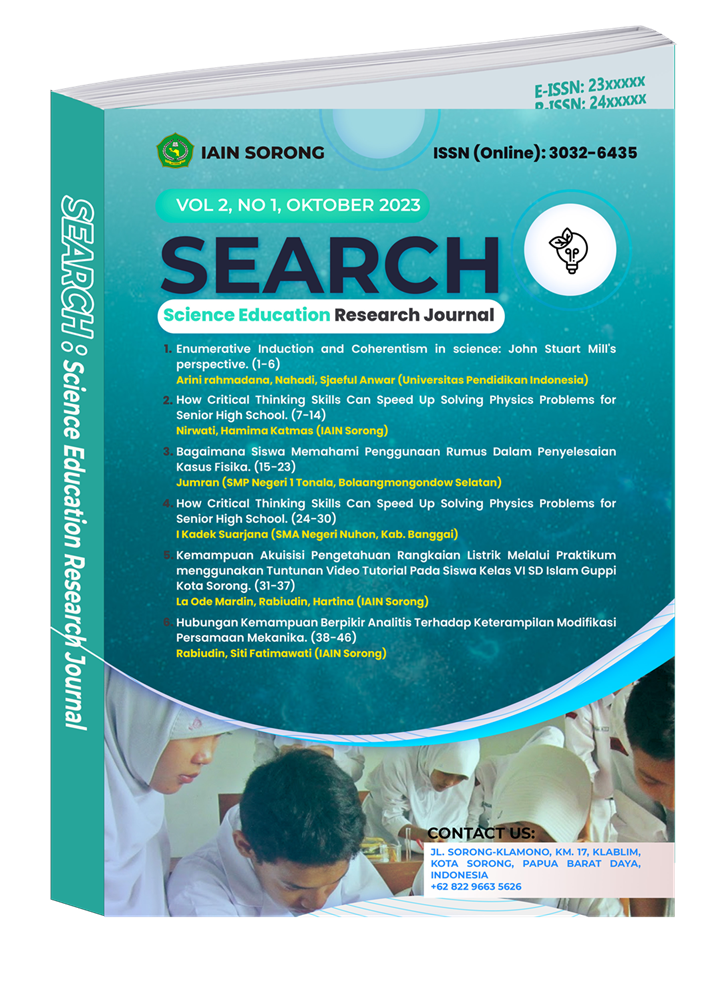Development of The “Ensiklopedia Tumbuhan” Flipbook as a Science Learning Resource in Elementary School
Pengembangan Flipbook “Ensiklopedia Tumbuhan” Sebagai Sumber Belajar Sains di Sekolah Dasar
DOI:
https://doi.org/10.47945/search.v4i`1.2218Keywords:
Flipbook, Encyclopedia, Learning Resource, Science, Elementary SchoolAbstract
The development of science and technology has accelerated, so education needs new technology. Teachers are limited in their use of digital science learning media in elementary schools. Books are not being used as full science learning resources, so new learning media are needed. This study aims to develop a flipbook called "Ensiklopedia Tumbuhan" for elementary school students to learn science. This research constitutes a development study (Research and Development) employing the ADDIE model, which comprises the following stages: The sequence of these phases is as follows: analysis, design, development, implementation, and evaluation. The research was conducted from April 2022 to August 2023. The research subjects were fourth-grade students enrolled at SDIT Samawi, Bantul. The data collection techniques employed in this study involved the administration of questionnaires. The analysis employed quantitative descriptive analysis techniques, with data calculated using Microsoft Excel. The flipbook media "Ensiklopedia Tumbuhan" was deemed suitable based on evaluations by subject matter experts, media experts, and field testing results with elementary school students. Research results show that the "Ensiklopedia Tumbuhan" flipbook product is suitable for elementary science education, with an average score of 98.46% and the highest "A" rating from subject experts. The pilot test of the "Ensiklopedia Tumbuhan" flipbook as a learning resource also had an average score of 86% in the "highly suitable" category.
References
Adawiyah, R., & Kartika, I. (2021). Pengembangan Ensiklopedia IPA Berbasis Integrasi-Interkoneksi Islam-Sains Sebagai Sumber Belajar Mandiri Peserta Didik Madrasah Tsanawiyah. Edusains, 13(1), 34–44. https://doi.org/10.15408/es.v13i1.12970.
‘Ainiyah, Q., & Masithoh, D. (2023). Analisis Peran Guru dan Orang Tua dalam Pembelajaran Daring Selama Pandemi Covid-19 di Madrasah Ibtidaiyah Al-Mumtaz Patuk Gunungkidul Yogyakarta. Competitive: Journal of Education, 2(1), 42–52. https://doi.org/10.58355/competitive.v2i1.14.
Asriani, W., Rahmadana, A., & Wokas, F. (2024). Analysis of Prospective Primary School Teachers’ Innovative Ideas on How to Teach Science So that Students Enjoy It More. Search: Science Education Research Journal, 3(1), 36–45. https://doi.org/10.47945/search.v3i1.1480.
Billah, A., & Sarwanto. (2021). Pengembangan Media Pembelajaran IPA Pokok Bahasan Mata Manusia Berbasis Android. Inkuiri: Jurnal Pendidikan IPA, 9(2), 85–91. https://doi.org/10.20961/inkuiri.v9i2.50070.
Bujuri, D. A., Ananda, N., Saputra, A. D., & Handayani, T. (2022). Pengembangan Bahan Ajar Tematik Berbasis Model Pembelajaran Contextual Teaching and Learning di Madrasah Ibtidaiyah Swasta. Sittah: Journal of Primary Education, 3(2), 117–132. https://doi.org/10.30762/sittah.v3i2.495.
Cristiana, D. I., Anjarini, T., & Purwoko, R. Y. (2021). Pengembangan Modul Pembelajaran IPA Berbasis Kontekstual Materi Suhu dan Kalor di Sekolah Dasar. Sittah: Journal of Primary Education, 2(2), 145–160. https://doi.org/10.30762/sittah.v2i2.3400.
Erawati, Y., Raharjo, & Azizah, U. (2020). Pengembangan Media Ensiklopedia Bentuk dan Fungsi Tumbuhan Melatihkan Berpikir Kritis Siswa Sekolah Dasar. Jurnal Bidang Pendidikan Dasar, 4(2), 195–205. https://doi.org/10.21067/jbpd.v4i2.4389.
Hana, W. F., Ekaningtias, M., & Jannah, S. W. (2020). Desain Pengembangan Ensiklopedia Tanaman Obat Berbasis Potensi Lokal di Pulau Lombok. Oryza: Jurnal Pendidikan Biologi, 9(2), 36–41. https://doi.org/10.33627/oz.v9i2.387.
Harahap, F., Nurliza, & Nasution, N. E. A. (2020). Pengembangan Ensiklopedia Perbanyakan Tanaman Melalui Kultur Jaringan Sebagai Sumber Belajar Tambahan untuk Siswa SMA. Jurnal Pelita Pendidikan, 8(1), 52–61. https://doi.org/10.24114/jpp.v8i1.17301.
Herawati, V. (2022). Pengembangan Media Pembelajaran IPA dengan Menggunakan Media “Rumah Eksis” di Sekolah Dasar. Jurnal Basicedu, 6(1), 1341–1349. https://doi.org/10.31004/basicedu.v6i1.2297.
Irfandi, I., & Murwindra, R. (2022). Development of Critical Thinking Problems Using The Wondershare Quiz Creator Application on Salt Hydrolysis Materials. Jnanaloka, 3(2), 67–74. https://doi.org/10.36802/jnanaloka.2022.v3-no2-67-74.
Karimah, N., Ngazizah, N., & Ratnaningsih, A. (2021). Pengembangan Ensiklopedia Digital Berbasis Keterampilan Proses dan Karakter Pada Kelas V Tema Lingkungan Sahabat Kita. Syntax Idea, 3(8), 1924–1936. https://doi.org/10.46799/syntax-idea.v3i8.1429.
Kartika, I., & Ibrahim. (2020). Efektivitas Ensiklopedia IPA Terintegrasi Alquran untuk Siswa Tunanetra. Inklusi: Journal of Disability Studies, 7(2), 229–252. https://doi.org/10.14421/ijds.070203.
Lestari, K. K. (2025). Pengembangan Media Pembelajaran berbasis Video Animasi Mata Pelajaran IPAS di SDN 37 Kota Sorong. Search: Science Education Research Journal, 3(2), 93–102. https://doi.org/10.47945/search.v3i2.1798.
Marwatan, M. (2022). Upaya Meningkatkan Hasil Belajar Matematika Peserta Didik Pada Materi Pecahan Nilai Uang Melalui Metode Demonstrasi di Kelas II SDN 146/X Tanjung Solok. Journal on Education, 4(2), 437–447. https://doi.org/10.31004/joe.v4i2.463.
Masithoh, D. (2018). Teachers’ Scientific Approach Implementation in Inculcating The Students’ Scientific Attitudes. Jurnal Prima Edukasia, 6(1), 32–43. https://doi.org/10.21831/jpe.v6i1.14282.
Masithoh, D. (2021). Penerapan Metode Genius Learning Strategy Sebagai Upaya Meningkatkan Prestasi Belajar IPA di Sekolah Dasar. Joned: Journal of Nusantara Education, 1(1), 1–8. https://doi.org/10.57176/jn.v1i1.1.
Pemerintah Republik Indonesia. (2003). Undang-Undang Republik Indonesia Nomor 20 Tahun 2003 Tentang Sistem Pendidikan Nasional. BPK. https://peraturan.bpk.go.id/Details/43920/uu-no-20-tahun-2003.
Priatama, W., Hamidah, A., & Anggereini, E. (2020). Ensiklopedia Keanekaragaman Ikan di Danau Kerinci Sebagai Sumber Belajar Berbasis Android. Biodik: Jurnal Ilmiah Pendidikan Biologi, 7(2), 45–54. https://doi.org/10.22437/bio.v7i2.13030.
Putria, H., Maula, L. H., & Uswatun, D. A. (2020). Analisis Proses Pembelajaran Dalam Jaringan (Daring) Masa Pandemi Covid-19 Pada Guru Sekolah Dasar. Jurnal Basicedu, 4(4), 861–870. https://doi.org/10.31004/basicedu.v4i4.460.
Rambe, N., & Masithoh, D. (2023). Efektivitas Pembelajaran Daring Menggunakan Media WhatsApp Group terhadap Hasil Belajar Kompetensi IPA di Sekolah Dasar. Joned: Journal of Nusantara Education, 2(2), 46–52. https://doi.org/10.57176/jn.v2i2.42.
Richana, A., & Masithoh, D. (2023). Upaya Peningkatan Hasil Belajar IPA Siswa Kelas IV Melalui Pendekatan Ekspositori di Sekolah Dasar. Primer: Journal of Primary Education Research, 1(1), 40–46. https://e-journal.unu-jogja.ac.id/pgsd/index.php/primer/article/view/2.
Risabethe, A., & Astuti, B. (2017). Pengembangan Media Pembelajaran untuk Meningkatkan Motivasi Belajar dan Karakter Semangat Kebangsaan Siswa Kelas V SD. Jurnal Pendidikan Karakter, 7(1), 34–45. https://doi.org/10.21831/jpk.v7i1.15498.
Sugiyono. (2018). Metode Penelitian Pendidikan Pendekatan Kuantitatif, Kualitatif, dan R&D. Alfabeta.
Wahyu, Y., Edu, A. L., & Nardi, M. (2020). Problematika Pemanfaatan Media Pembelajaran IPA di Sekolah Dasar. Jurnal Penelitian Pendidikan IPA, 6(1), 107–112. https://doi.org/10.29303/jppipa.v6i1.344.








